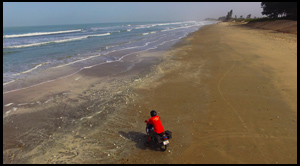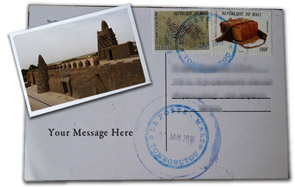This is me making doughnut batter in Ghana. I am wearing my favorite shirt. It is lightweight, comfortable, mildly flattering, quick-drying, and somewhat immune to odor. Three years ago, before boarding an overnight bus to Arequipa, I was robbed in the Cusco bus station. I got on the bus with nothing except for passport, cash, and credit cards. When I arrived in Arequipa, me and my two traveling companions I had met at my hostel in Cusco (Andrew and Nicky, come to Mali), reassembled my bag in the main market area. I bought a knock off addidas backpack, three shirts, a pack of underwear, toothbrush, toothpaste, and soap. I already had a pair of pants. I would wear them every day for the rest of the trip. I did not buy a new camera. By the next day I had forgotten about my stolen belongings. Having no camera turned out to be a luxury and I ended up buying a more fashionable wardrobe than I had before.
One of the shirts I bought in the Arequipa market was the blue one pictured above. I paid $6 for it. It has lasted three years. It has been relatively indestructible. But now, in Africa, it is beginning to disintegrate. Humidity, the equatorial sun, and frequent washing being the culprits. I will be surprised if it makes it past Mali. But it doesn’t matter. I will just buy another $6 shirt.
For the month of September I spent roughly $140 (I’m not including the absurd visa to Mali in this number). Between my elevator mishap and couchsurfing, I did not pay for one night of lodging in Cote D’Ivoire. A chunk of money was spent on overpriced food when I was staying at the hotel. After that, I was eating delicious meals for $15 a week. That’s how much it costs for a week’s bounty from a market in Abidjan. I bought some drinks here and there, some street food (poulet braisee) and I spent a small amount on transportation. Faty and David are extremely frugal themselves. When it came time to find a ride home from somewhere in the city, we typically took some combination of gbakas and shared taxis to get there. While these journeys took longer, they were always entertaining and they were dirt cheap.
The point in all this is that you don’t need much money. Or things. Right now, this is my luggage:
I bought the backpack at Kmart over five years ago. The laptop bag was given to me by David Orr, who by the way writes an awesome column on sustainable food here. I have four shirts, two pairs of shorts, one pair of pants. One pair of shoes: flip flops. Two pairs of underwear.
During my month in Cote D’Ivoire I met great people, discovered Ivorian culture, listened to new music, created some of my own, ate delicious food, and unearthed my French. There was some camel drawing. There was some romance.
$140. Two pairs of underwear.
Up next: My first impressions of Bamako. And later, plasmodium falciparum.





Thanks for the shout-out Phil. You are missed and loved.
The feeling is mutual
Its really an amazing tour Phil….
James